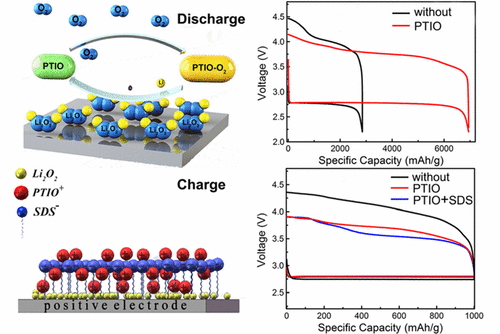当前位置:
X-MOL 学术
›
ACS Energy Lett.
›
论文详情
Our official English website, www.x-mol.net, welcomes your
feedback! (Note: you will need to create a separate account there.)
Bifunctional Redox Mediator Supported by an Anionic Surfactant for Long-Cycle Li–O2 Batteries
ACS Energy Letters ( IF 19.3 ) Pub Date : 2017-10-30 00:00:00 , DOI: 10.1021/acsenergylett.7b00884 Chengyang Xu 1 , Guiyin Xu 1 , Yadi Zhang 1 , Shan Fang 1 , Ping Nie 1 , Langyuan Wu 1 , Xiaogang Zhang 1
ACS Energy Letters ( IF 19.3 ) Pub Date : 2017-10-30 00:00:00 , DOI: 10.1021/acsenergylett.7b00884 Chengyang Xu 1 , Guiyin Xu 1 , Yadi Zhang 1 , Shan Fang 1 , Ping Nie 1 , Langyuan Wu 1 , Xiaogang Zhang 1
Affiliation

|
Although the soluble redox mediator (RM) has been effectively applied in Li–O2 batteries, parasitic reactions between the lithium anode and RM+ can result in poor cycle performance. Herein, we proposed a nonelectroactive surfactant (sodium dodecyl sulfate, SDS) that could adsorb on the hydrophobic carbon surface and form a stable anionic layer upon charge, which can effectively suppress the diffusion of oxidized RM+ and facilitate charge transfer at the electrode–solution interface. To coordinate with SDS, a new RM named 2-phenyl-4,4,5,5-tetramethylimidazoline-1-oxyl-3-oxide (PTIO) was adopted due to its oxidation process following after in situ formation of the anionic layer. Moreover, as a bifunctional mediator, PTIO cannot only get a low charge plateau but also greatly enhance the discharge capacity when applied in Li–O2 batteries. The electrochemical results demonstrated that the cycling performance, energy efficiency, and discharge capacity were significantly improved owing to the synergistic effect of PTIO and SDS.
中文翻译:

阴离子表面活性剂支持的双功能氧化还原介体,用于长周期Li–O 2电池
尽管可溶性氧化还原介体(RM)已有效地应用于Li-O 2电池,但锂阳极与RM +之间的寄生反应可能导致较差的循环性能。本文中,我们提出了一种非电活性表面活性剂(十二烷基硫酸钠,SDS),该表面活性剂可以吸附在疏水性碳表面上,并在充电后形成稳定的阴离子层,可以有效抑制氧化的RM +的扩散。并促进电极-溶液界面处的电荷转移。为了与SDS配合,由于原位形成阴离子层之后的氧化过程,采用了一种新的RM,称为2-苯基-4,4,5,5-四甲基咪唑啉-1-氧基1-3氧化物(PTIO)。此外,作为双功能介体,PTIO在Li-O 2电池中使用时,不仅充电平台稳定,而且放电容量大大提高。电化学结果表明,由于PTIO和SDS的协同作用,循环性能,能效和放电容量得到了显着改善。
更新日期:2017-10-30
中文翻译:

阴离子表面活性剂支持的双功能氧化还原介体,用于长周期Li–O 2电池
尽管可溶性氧化还原介体(RM)已有效地应用于Li-O 2电池,但锂阳极与RM +之间的寄生反应可能导致较差的循环性能。本文中,我们提出了一种非电活性表面活性剂(十二烷基硫酸钠,SDS),该表面活性剂可以吸附在疏水性碳表面上,并在充电后形成稳定的阴离子层,可以有效抑制氧化的RM +的扩散。并促进电极-溶液界面处的电荷转移。为了与SDS配合,由于原位形成阴离子层之后的氧化过程,采用了一种新的RM,称为2-苯基-4,4,5,5-四甲基咪唑啉-1-氧基1-3氧化物(PTIO)。此外,作为双功能介体,PTIO在Li-O 2电池中使用时,不仅充电平台稳定,而且放电容量大大提高。电化学结果表明,由于PTIO和SDS的协同作用,循环性能,能效和放电容量得到了显着改善。











































 京公网安备 11010802027423号
京公网安备 11010802027423号